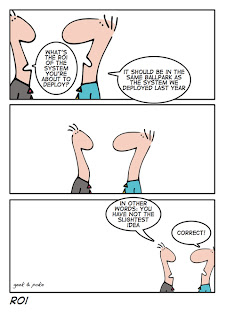Determining the ROI on HR Business Systems – or Not
Return on Investment (aka ROI) implies at some future point you get your money back after the investment is made. There is an initial financial investment, and an eventual “return” of those dollars (and then some, hopefully) down the road.
Depending on the system being implemented, calculating your potential ROI can be simple math or a much more complex process. Are there truly hard-dollar quantifiable savings — elimination of paper records and storage, staffing cuts, etc? Or are the savings more in the soft-dollar category, such as time saved or greater employee satisfaction? Probably, with HR systems, it will be a combination of both.
Calculating the Total Cost of Ownership
First you have the task of attempting to accurately quantify the numbers. How much does all that paper actually cost? And did the staff cuts force new overtime pay for the remaining employees, cutting FTEs with little to no drop in overall payroll expense? Did employee satisfaction improvements result in measurable productivity gains and/or lower turnover? Can you even determine that?
For some systems ROI analysis can be a no-brainer. In larger organizations automated time and attendance systems WILL reduce payroll preparation times dramatically vs. manual time keeping, and are proven to virtually eliminate paycheck errors. And as anyone can expect, paycheck errors in the employee’s favor may not be reported (unless there is a gross error), contrary to errors that short the employee pay. Therefore errors (both for and against employees) do not cancel themselves out. A simple report comparing payroll expense pre- and post-automation tells the whole story. Not to mention the lower stress levels in the newly automated payroll department.
Well-tuned HR Help Desk systems with robust employee self-service features are proven to reduce unnecessary calls into HR, potentially cutting new cases by as much as 50% or more over time as employees gain comfort with the new services. Not to mention the “soft-dollar” benefits of consistent application of company policies, powerful case analytics, adherence to SLA policies, and more. No matter how you slice it, that is real ROI.
Cloud vs. On-premises ROI Comparison
Which deployment option provides the greatest benefit at the lowest cost? Clearly, Cloud and SaaS will provide the lowest cost solution. Sometimes this decision is driven more by security concerns and the desire for customizations rather than financial ones. Calculating the cost difference of SaaS vs. hosted vs. on-premises deployments is fairly straight forward, but generally this decision is based on factors other than costs. Many vendors such as LBi are flexible (offering multiple alternatives) and leave this decision to the client.
Building a Business Case
It all boils down to whether or not conducting an ROI analysis is a beneficial or necessary exercise. Does upper management require one to be performed? Is a reasonable financial return a condition of the purchase approval? What is a “reasonable” return on investment? 2 year payback? 3 years?
And is an RFP mandated? We will save that discussion for a future post.
One philosophy many companies are adopting is stated in the old adage — “if the shoe fits, wear it”. If you have the budget, and have concrete reasons to believe the new system will improve HR operations, then go for it. No ROI (or RFP) needed. Sometimes overthinking the decision process can be a bad thing — unnecessarily prolonging the project, with little or no added benefit from over analyzing the analysis. The sooner HR realizes the benefits of the new system, the better.
Let’s assume when all is said and done that you must conduct an ROI analysis. Below are the factors you should consider for most HCM solution evaluations, comparing each element before and after deployment:
Current and Post Implementation Impact Comparison – Hard Dollars
- Department Payroll (HR and IT staff) – FTE Count
- Admin, Manager, CSR/Agent, IT staff
- Overhead (benefits, expense accounts, office supplies, etc.)
- Software license, hardware, deployment, ongoing support, and other systems costs
- Be sure you have accurately calculated the Total Cost of Ownership (TCO)
- Any other tangible hard dollar costs and savings
Post Implementation Impact – Soft Dollars
- Hours saved per month/year by role (admin, manager, agent, etc.)
- Value of improved accuracy – fewer errors
- Greater reliability/faster support
- Value of employee satisfaction
- Value of analytics/improved forecasting
- Value of increased employee productivity and reduced turnover
- Any other real or perceived value derived from the new system
Just because a new system may not necessarily deliver direct cost savings, that doesn’t imply the system will not provide significant measurable value to HR. Very often the soft dollar benefits are substantial and obvious. Sometimes there are no cost savings at all, but the soft benefits far outweigh the added expense.
So the next time the Finance folks say “Show me the money”, be sure you show them the whole picture. For more on ROI of HR Case Management for smaller companies download our eBook.






